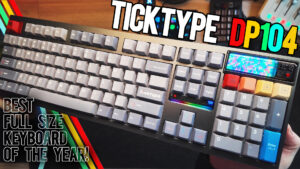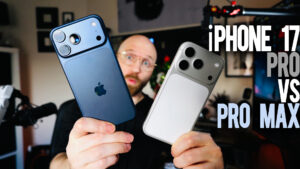Cerakey Matte Keycaps Review: Thock as Thock Can Be!
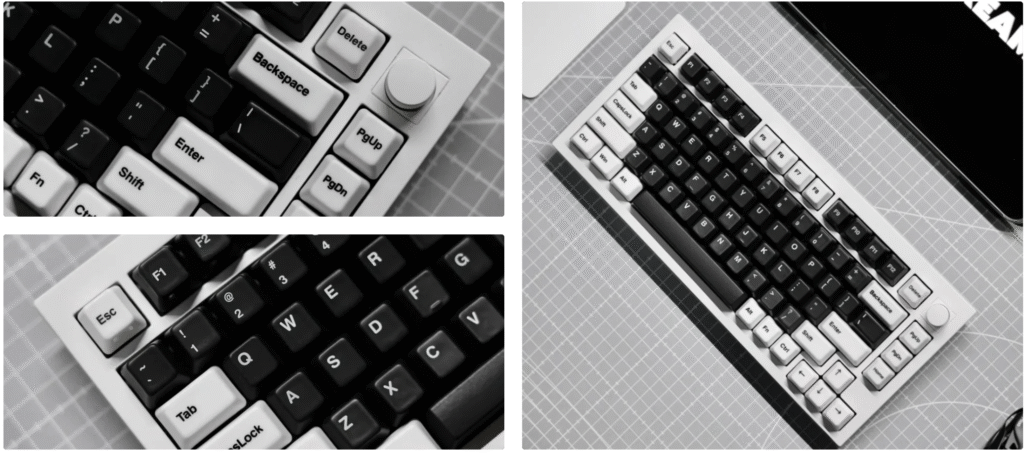
First Impressions and Setup
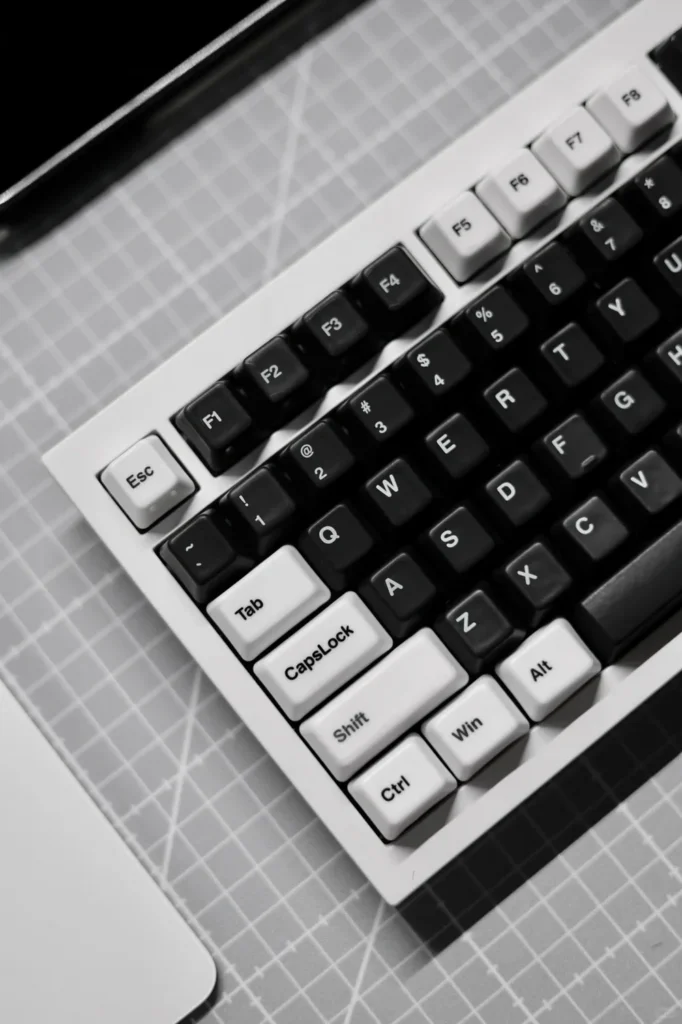

Mix-and-match fun with black and white Cerakey matte keycaps. The matte ceramic finish looks clean and resists fingerprints, unlike the earlier glossy version. Best of both worlds!
I couldn’t wait to get my hands on the Cerakey Matte Ceramic Keycaps, a full set of smooth ceramic caps with a new matte finish. As a mechanical keyboard enthusiast, I popped these onto two of my favorite boards to give them a whirl: my Monsgeek (with “creamy” linear switches) and my Wooting (a Hall-effect board rocking Geon Raw switches). Installation was mostly straightforward: the keycaps use a Cherry MX compatible stem, so they technically fit on any MX-style switch. Most keys pressed on snugly and instantly gave the keyboards a premium, weighty feel. From the first press, I could tell these weren’t your average plastic caps, they’re literally made of alumina ceramic, known for exceptional hardness (second only to diamond!) and durability. In other words, these caps feel solid as a rock under your fingers.
One small hiccup during setup was the spacebar. On one of my boards, the long 6.25u spacebar didn’t quite cooperate, it would get stuck in the chassis. Cerakey had claimed to improve this in Version 2 with a new plastic stem design for better stability, and they even include a heavier switch in the box to help support the hefty spacebar. But in my case, the spacebar still gave me trouble fitting perfectly (so much for “fixed,” huh?). I eventually got it to behave with a little DIY trick (a tiny paper shim in the stem), a known workaround since the first version. It’s not a deal-breaker, but it’s something to be aware of. Once that drama was resolved, though, it was time for the real fun: typing away on these ceramic wonders!
Typing Sound & Feel: The True Thock Experience
The sound profile of the Cerakey matte keycaps is nothing short of magical. If you’re chasing that deep “thock” sound, these keycaps deliver it in spades. The moment I started typing, my Monsgeek and Wooting both transformed from gentle clickety-clacks into rich, thocky sound machines. The higher density and thickness of ceramic compared to plastic give each keystroke a satisfyingly deep report, thock with a capital “T”. In fact, the keys sounded deeper and more mellow than I expected, completely avoiding any high-pitched plasticky ping. As the community likes to say, these caps are as thock as thock can be (truly chef’s kiss in the sound department). Cerakey’s own description promises a “deep, satisfying thocky typing sound” from the alumina ceramic material, and they’re not kidding. Both the creamy linears and the hall-effect switches were enhanced by the ceramic caps’ acoustics, each press felt like tapping a tiny drum that goes “thump” instead of “tick.” I found myself happily typing nonsense just to hear that thocky symphony.
Beyond sound, the typing feel is surprisingly comfortable. Ceramic might sound hard (and yes, these caps are physically harder and heavier than plastic), but the matte finish gives a nice soft-touch feel to the fingertips. There’s a subtle texture that’s gentle on the fingers and provides a bit of grip, so your fingers won’t slide off even during furious typing or gaming. The keys have a solid, stable bottom-out, no flex or give, which makes each keystroke feel consistent and precise. It’s like typing on sturdy little porcelain tiles that love being pressed. Despite the weight, I didn’t experience finger fatigue in normal use, and the smooth travel of my switches combined with the heft of the caps made for a very satisfying, almost cushioned bottom-out. In short, the Cerakey keycaps turned my keyboards into thocky, silky-smooth typing dream machines.
Texture & Looks: Best of Both Worlds (Matte vs. Glossy)

One of the first things I noticed was the matte finish on these keycaps, and I absolutely love it. Cerakey previously offered glossy ceramic caps, which looked cool but were total fingerprint magnets (every touch left a mark, eek!). These new Matte Cerakeys truly are the best of both worlds: they have a nice semi-frosted sheen without the smudgy downside. The specialized matte glaze gives a non-reflective, lightly textured surface that resists fingerprints and smudges, so my keyboard stays looking clean even after long typing sessions. No more wiping keys every ten minutes, the matte caps hide fingerprints like a charm, yet they still feel smooth to the touch. The texture is hard to describe: it’s not gritty at all, more like a satin finish. It provides a slight grip, making typing feel secure (no slippery keys), but it’s also silky. Think of a fine ceramic mug, that kind of pleasant, smooth matte feel. It’s really unique compared to standard ABS or PBT plastic keycaps.
In terms of visuals, these keycaps are stunning in a subtle, classy way. I got my set in both black and white, which means I can mix and match them to create a striking two-tone look. And boy, have I had fun with that! Sometimes I deck out my board in a classic black-and-white “panda” scheme, white alphas, black modifiers, or vice versa. The legends (I opted for the version with legends) are crisp and easy to read, fired into the ceramic so they’re part of the keycap (no worries about fading). The black set looks bold and stealthy, while the white set looks clean and futuristic. Mixing them gives my keyboard a playful personality, almost like having a custom keycap theme I can tweak on a whim. The matte finish on both colors means they diffuse light and have a gentle glow under lighting (more on that next), instead of a harsh shine. And importantly, unlike the old glossy ceramic caps that had a mirror-like shine, these matte ones don’t reflect everything, so you see their actual color and form clearly, under all lighting conditions. Personally, I adore this look: it’s like my keyboard keys are carved from stone or fine pottery, and it adds a distinctively premium vibe to my desk setup. Plus, no gross oily shine, just pure matte aesthetics all the time. Win-win!
RGB Shine-Through Magic
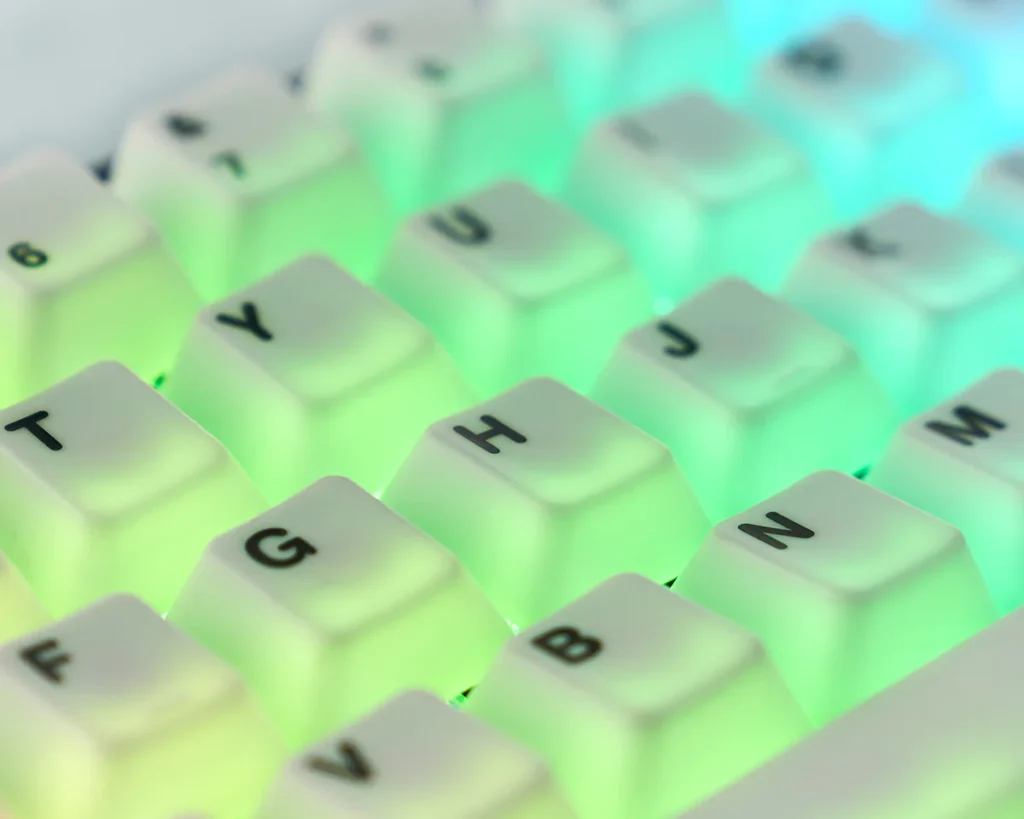
RGB lighting looks otherworldly with Cerakey caps, the entire keycap illuminates with vibrant color. Ceramic allows more light through than plastic, creating a unique underglow and shine-through effect!
If you think these keycaps sound and feel great, wait until you see them light up. The Cerakey caps have an amazing RGB shine-through quality that I’ve never seen in other keycaps. Since they’re made of a translucent ceramic material, the entire keycap can glow when you have backlighting, not just the legends. When I turned on the per-key RGB on my boards, I was greeted with a light show. The effect is downright magical: the keys don’t just shine, they glow. It’s like each keycap is a tiny lantern, diffusing the light evenly through the matte ceramic. Cerakey actually mentions that ceramic has greater light transmittance than plastic, allowing more light to shine through for peak vibrant RGB illumination. I can confirm this is true, the RGB on my keyboards suddenly looked twice as bright and rich. The colors blend softly, and there are no harsh hotspots; the whole keycap face just lights up in a uniform hue.
What’s really cool is that even the black keycaps glow nicely. Normally, black keycaps with shine-through legends don’t show much, but these have a white inner layer (the underside of the ceramic is white) that helps reflect light. It’s a feature that really highlights the uniqueness of ceramic as a keycap material and had me grinning like a kid at a light parade.
Spacebar Woes (And Workarounds)
Alright, let’s talk about the one real issue I encountered: the spacebar. I hinted earlier that the spacebar gave me some trouble, and indeed it was the only thorn in an otherwise rosy experience. The Cerakey spacebar is a hefty piece of ceramic (about 6.25 units long). That weight, combined with slightly finicky stems, means it doesn’t always play nice with every keyboard’s stabilizers. On my Monsgeek, the spacebar fit okay; but on my Wooting, it was getting stuck in the chassis. This seems to be a known quirk, the original Cerakey V1 had reports of loose or misfitting spacebars, and while V2’s plastic stem was supposed to fix it, clearly some issues persist.
It’s also worth noting the ceramic spacebar is heavier than a plastic one, so if you use very light switch springs, the spacebar might struggle to spring back up properly. Cerakey anticipated this by including a couple of heavy springs/switches specifically for the spacebar in the package. I ended up using a heavier switch for the space key, which helped with the return force. And to eliminate the looseness, I applied the old keyboard trick: a tiny piece of tape (or paper) on the stabilizer pegs to tighten the fit. After that little fix, the spacebar stayed put and worked fine. Still, they said they addressed the spacebar problem, but it still showed up on my board. It’s a minor disappointment given the premium price of these caps. The good news is the fix was easy, and Cerakey’s support is reportedly responsive with replacements if you get a truly faulty cap. Just go in knowing you might need to do a bit of tinkering for that spacebar, especially if your board’s stabilizer tolerances aren’t snug. Once sorted, the spacebar thocks just as beautifully as the other keys (maybe even more so, it produces a big, deep “THOCK”)
Conclusion: Thocky Bliss Achieved (Plus a New Wishlist!)
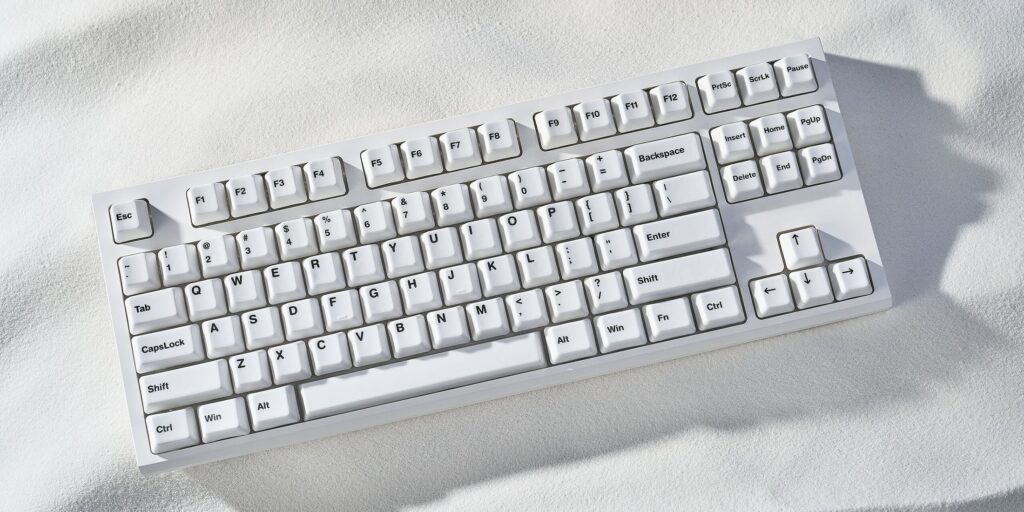
After spending quality time with the Cerakey Matte keycaps, I can confidently say they’ve turned my keyboard experience to something truly special. The sound is a thocky dream come true, my keyboards have never sounded deeper or more satisfying. The feel is premium and comfortable, turning every keystroke into a tiny indulgence. And the looks? Simply gorgeous. The matte ceramic finish gives me the clean aesthetics I’ve always wanted (no more fingerprint horror stories), and the unique shine-through glow is a show-stopper for anyone who sees my setup. Are these keycaps perfect? Not quite, the spacebar saga was real, and these caps aren’t cheap (they’re a luxury, niche item for sure). But overall, the pros heavily outweigh the cons in my book. I’m typing this review on the Cerakeys right now, and I’m honestly a bit enchanted by the clack-thock rhythm and the sight of softly glowing keys under my fingers. They’ve made both my Monsgeek and Wooting keyboards sound and look better than ever. It’s not often you find an upgrade that noticeably improves both acoustics and visuals in such a fun way, but Cerakey pulled it off with these ceramic caps.
Do I recommend these? If you’re an enthusiast who loves trying new materials and chasing that ultimate thock, absolutely yes, give them a shot (just keep a heavier spring handy for the spacebar). They’re a conversation piece and a delight to use. My only warning would be the quirks we discussed and the premium price tag, but hey, you’re essentially getting handcrafted ceramic art for your keyboard, and it feels like it. I’m already mixing and matching keycaps and enjoying the heck out of them.
Glass Mouse Pad: Now That’s a Companion I’m Craving

And before I wrap up, I have to mention one more thing on my personal wishlist: Cerakey also makes these artisan glass mouse pads, and oh my goodness, have you seen those designs? They’re tempered glass with stunning artistic prints (like the San Yan mountain/sea design), basically desk art you can use as a mousepad. After experiencing the keycaps, I’m dying to try one of those glass pads next. Imagine a beautiful glass pad to complement my thocky ceramic keyboard, the combo would be an aesthetic paradise!

